The Preparation Phase of the 2022 ML 5.7 Offshore Fano (Italy) Earthquake: A Multiparametric–Multilayer Approach
Abstract
:1. Introduction
2. Seismotectonic Settings
3. Data and Methods
3.1. Lithospheric Data
3.2. Atmospheric Data
3.3. Ionospheric Data
4. Results
4.1. Lithospheric Data Analysis
4.2. Atmospheric Data Analysis
4.3. Ionospheric Data Analysis
4.3.1. Ionosonde Data Analysis
4.3.2. Swarm Satellite Data Analysis
4.3.3. NOAA Satellite Data Analysis: Electron Burst Data Analysis
5. Discussion
6. Conclusions
Author Contributions
Funding
Data Availability Statement
Acknowledgments
Conflicts of Interest
References
- Hayakawa, M. Electromagnetic phenomena associated with earthquakes: A frontier in terrestrial electromagnetic noise environment. Recent Res. Dev. Geophys. 2004, 6, 81–112. [Google Scholar]
- Freund, F. Pre-earthquake signals: Underlying physical processes. J. Asian Earth Sci. 2011, 41, 383–400. [Google Scholar] [CrossRef]
- Dahlgren, R.P.; Johnston, M.J.S.; Vanderbilt, V.C.; Nakaba, R.N. Comparison of the Stress-Stimulated Current of Dry and Fluid-Saturated Gabbro Samples. Bull. Seismol. Soc. Am. 2014, 104, 2662–2672. [Google Scholar] [CrossRef]
- Freund, F. Charge generation and propagation in igneous rock. J. Geodyn. 2002, 33, 543–570. [Google Scholar] [CrossRef]
- Freund, F. Electric currents streaming out of stressed igneous rocks: A step towards understanding pre-earthquake low frequency EM emissions. Phys. Chem. Earth 2006, 31, 389–396. [Google Scholar] [CrossRef]
- Freund, F. Pre-earthquake signals, Part I: Deviatoric stresses turn rocks into a source of electric current. Nat. Hazards Earth Syst. Sci. 2007, 7, 535–541. [Google Scholar] [CrossRef]
- Scoville, J.; Heraud, J.; Freund, F. Pre-earthquake magnetic pulses. Nat. Hazards Earth Syst. Sci. 2015, 15, 1873–1880. [Google Scholar] [CrossRef]
- Pulinets, S.; Ouzounov, D. Lithosphere–Atmosphere–Ionosphere Coupling (LAIC) model—An unified concept for earthquake precursors validation. J. Southeast Asian Earth Sci. 2011, 41, 371–382. [Google Scholar] [CrossRef]
- Surkov, V.V.; Pilipenko, V.A.; Silina, A.S. Can Radioactive Emanations in a Seismically Active Region Affect Atmospheric Electricity and the Ionosphere? Izv. Phys. Solid Earth 2022, 58, 297–305. [Google Scholar] [CrossRef]
- Schekotov, A.; Hayakawa, M.; Potirakis, S.M. Does air ionization by radon cause low-frequency atmospheric electromagnetic earthquake precursors? Nat. Hazards 2021, 106, 701–714. [Google Scholar] [CrossRef]
- Hayakawa, M.; Molchanov, O.A.; NASDA/UEC Team. Summary report of NASDA’s earthquake remote sensing frontier project. Phys. Chem. Earth 2004, 29, 617–625. [Google Scholar] [CrossRef]
- Molchanov, O.A.; Hayakawa, M. Seismo Electromagnetics and Related Phenomena: History and Latest Results; Terra Sceintific Publishing: Tokyo, Japan, 2008; Volume 189. [Google Scholar]
- Korepanov, V.; Hayakawa, M.; Yampolski, Y.; Lizunov, G. AGW as a seismo-ionospheric coupling responsible agent. Phys. Chem. Earth 2009, 34, 485–495. [Google Scholar] [CrossRef]
- Akhoondzadeh, M. Investigation of the LAIC mechanism of the Haiti earthquake (August 14, 2021) using CSES-01 satellite observations and other earthquake precursors. Adv. Space Res. 2024, 73, 672–684. [Google Scholar] [CrossRef]
- Sasmal, S.; Chowdhury, S.; Kundu, S.; Politis, D.Z.; Potirakis, S.M.; Balasis, G.; Hayakawa, M.; Chakrabarti, S.K. Pre-seismic irregularities during the 2020 Samos (Greece) earthquake (M = 6.9) as investigated from multi-parameter approach by ground and space-based techniques. Atmosphere 2021, 12, 1059. [Google Scholar] [CrossRef]
- Nayak, K.; Romero-Andrade, R.; Sharma, G.; Cabanillas Zavala, J.L.; Làopez Urias, C.; Trejo Soto, M.E.; Aggarwal, S.P. A combined approach using b-value and ionospheric GPS-TEC for large earthquake precursor detection: A case study for the Colima earthquake of 7.7 Mw, Mexico. Acta Geod. Geophys. 2023, 58, 515–538. [Google Scholar] [CrossRef]
- Nayak, K.; Làopez-Uràias, C.; Romero-Andrade, R.; Sharma, G.; Guzmàan-Acevedo, G.M.; Trejo-Soto, M.E. Ionospheric Total Electron Content (TEC) anomalies as earthquake precursors: Unveiling the geophysical connection leading to the 2023 Moroccan 6.8 Mw earthquake. Geoscience 2023, 13, 319. [Google Scholar] [CrossRef]
- Shah, M.; Calabria Aiber, A.; Arslan Tariq, M.; Ahmed, J.; Ahmed, A. Possible ionosphere and atmosphere precursory analysis related to Mw > 6.0 earthquakes in Japan. Remote Sens. Environ. 2020, 239, 111620. [Google Scholar] [CrossRef]
- Sharma, G.; Nayak, K.; Romero-Andrade, R.; Mohammed Aslam, M.A.; Sarma, K.K.; Aggarwal, S.P. Low ionosphere density above the earthquake epicenter region of Mw 7.2, El Mayor-Cucapah earthquake evident from dense CORS data. J. Indian Soc. Remote Sens. 2024, 52, 543–555. [Google Scholar] [CrossRef]
- Tachema, A. Identifying pre-seismic ionospheric disturbances using space geodesy: A case study of the 2011 Lorca earthquake (Mw 5.1), Spain. Earth Sci. Inform. 2024, 17, 2055–2071. [Google Scholar] [CrossRef]
- De Santis, A.; Cianchini, G.; Marchetti, D.; Piscini, A.; Sabbagh, D.; Perrone, L.; Campuzano, S.A.; Inan, S. A Multiparametric Approach to Study the Preparation Phase of the 2019 M7.1 Ridgecrest (California, United States) Earthquake. Front. Earth Sci. 2020, 8, 40398. [Google Scholar] [CrossRef]
- Wang, Y.; Ma, W.; Zhao, B.; Yue, C.; Zhu, P.; Yu, C.; Yao, L. Responses to the preparation of the 2021 M7.4 Madoi earthquake in the Lithosphere-Atmosphere-Ionosphere System. Atmosphere 2023, 14, 1315. [Google Scholar] [CrossRef]
- Akhoondzadeh, M.; Marchetti, D. Study of the preparation phase of Turkey’s powerful earthquake (6 February 2023) by a geophysical multi-parametric fuzzy interference system. Remote Sens. 2023, 15, 2224. [Google Scholar] [CrossRef]
- Pezzo, G.; Billi, A.; Carminati, E.; Conti, A.; De Gori, P.; Devoti, R.; Lucente, F.P.; Palano, M.; Petracchini, L.; Serpelloni, E.; et al. Seismic source identification of the 9 November 2022 Mw 5.5 offshore Adriatic sea (Italy) earthquake from GNSS data and aftershock relocation. Sci. Rep. 2023, 13, 11474. [Google Scholar] [CrossRef]
- Grunthal, G. European Macroseismic Scale 1998 (EMS-98). Cahiers du Centre Europeen de Ge´odynamique et de Seismologie 15; Centre Européen de Geodynamique et de Seismologie: Luxembourg, 1998; 99p. [Google Scholar]
- Tertulliani, A.; Antonucci, A.; Berardi, M.; Borghi, A.; Brunelli, G.; Caracciolo, C.H.; Castellano, C.; D’Amico, V.; Del Mese, S.; Ercolani, E.; et al. (Gruppo Operativo Quest). Rapporto Macrosismico sul Terremoto del 9/11/2022 Della Costa Marchigiana [Data set]. Istituto Nazionale di Geofisica e Vulcanologia (INGV). 2022. Available online: https://quest.ingv.it/rilievi-macrosismici (accessed on 16 May 2024).
- Maesano, F.E.; Buttinelli, M.; Maffucci, R.; Toscani, G.; Basili, R.; Bonini, L.; Burrato, P.; Fedorik, J.; Fracassi, U.; Panara, Y.; et al. Buried alive: Imaging the 9 November 2022, Mw 5.5 earthquake source on the offshore Adriatic blind thrust front of the Northern Apennines (Italy). Geophys. Res. Lett. 2023, 50, e2022GL102299. [Google Scholar] [CrossRef]
- Dezi, F.; Merli, A. Chiaradonna A. Soil liquefaction potential of the central Adriatic Coast after the 9th of November 2022 earthquake (Italy). Jpn. Geotech. Soc. Spec. Publ. 2024, 10, 597–602. [Google Scholar] [CrossRef]
- Montone, P.; Mariucci, M.T. Deep well new data in the area of the 2022 Mw 5.5 earthquake, Adriatic Sea, Italy: In situ stress state and P-velocities. Front. Earth Sci. 2023, 11, 1164929. [Google Scholar] [CrossRef]
- Console, R.; Vannoli, P.; Carluccio, R. The 2022 Seismic Sequence in the Northern Adriatic Sea and Its Long-Term Simulation. Appl. Sci. 2023, 13, 3746. [Google Scholar] [CrossRef]
- Vannoli, P.; Basili, R.; Valensise, G. New geomorphic evidence for anticlinal growth driven by blind-thrust faulting along the northern Marche coastal belt (central Italy). J. Seismol. 2004, 8, 297–312. [Google Scholar] [CrossRef]
- Casero, P.; Bigi, S. Structural setting of the Adriatic basin and the main related petroleum exploration plays. Mar. Pet. Geol. 2013, 42, 135–147. [Google Scholar] [CrossRef]
- Ziegler, P.A. Compressional Irma plate deformation in the Alpine foreland. Tectonophysics 1987, 137, 420. [Google Scholar]
- Ziegler, P.A.; Cloetingh, S.; van Wees, J.D. Dynamics of intra-plate compressional deformation: The Alpine foreland and other examples. Tectonophysics 1995, 252, 7–59. [Google Scholar] [CrossRef]
- Doglioni, C. A proposal for the kinematic modelling of w-dipping subductions—Possible applications to the Tyrrhenian-Apennines system. Terra Nova 1991, 3, 423–434. [Google Scholar] [CrossRef]
- Bertotti, G.; Picotti, V.; Chilovi, C.; Fantoni, R.; Merlini, S.; Mosconi, A. Neogene to quaternary sedimentary basins in the South Adriatic (Central Mediterranean): Foredeeps and lithospheric buckling. Tectonics 2001, 20, 771–787. [Google Scholar] [CrossRef]
- Faccenna, C.; Jolivet, L.; Piromallo, C.; Morelli, A. Subduction and the depth of convection in the Mediterranean mantle. J. Geophys. Res. 2003, 108, 2099. [Google Scholar] [CrossRef]
- Doglioni, C.; Carminati, E.; Cuffaro, M. Simple kinematics of subduction zones. Int. Geol. Rev. 2006, 48, 479–493. [Google Scholar] [CrossRef]
- Patacca, E.; Scandone, P.; Di Luzio, E.; Cavinato, G.P.; Parotto, M. Structural architecture of the central Apennines. Interpretation of the CROP 11 seismic profile from the Adriatic coast to the orographic divide. Tectonics 2008, 27, TC3006. [Google Scholar] [CrossRef]
- Consiglio Nazionale delle Ricerche, Structural Model of Italy and Gravity Map; Quaderni de “La Ricerca Scientifica”; Progetto Finalizzato Geodinamica: Roma, Italy, 1992; Volume 3.
- DISS_Working_Group. Database of Individual Seismogenic Sources (DISS), Version 3.3.0: A Compilation of Potential Sources for Earthquakes Larger Than M 5.5 in Italy and Surrounding Areas; Istituto Nazionale di Geofisica e Vulcanologia: Roma, Italy, 2021.
- Fantoni, R.; Franciosi, R. Tectono-sedimentary setting of the Po Plain and Adriatic foreland. Rend. Fis. Acc. Lincei 2010, 21, 197–209. [Google Scholar] [CrossRef]
- Kastelic, V.; Vannoli, P.; Burrato, P.; Fracassi, U.; Tiberti, M.M.; Valensise, G. Seismogenic sources in the Adriatic Domain. Mar. Pet. Geol. 2013, 42, 191–213. [Google Scholar] [CrossRef]
- Elter, P.; Giglia, G.; Tongiorgi, M.; Trevisan, L. Tensional and Compressional Areas in the Recent (Tortonian to Present) Evolution of the Northern Apennines. Boll. Geofis. Teor. Appl. 1975, 17, 3–18. [Google Scholar]
- Rovida, A.N.; Locati, M.; Camassi, R.D.; Lolli, B.; Gasperini, P.; Antonucci, A. Catalogo Parametrico dei Terremoti Italiani CPTI15; Versione 4.0; Istituto Nazionale di Geofisica e Vulcanologia (INGV): Roma, Italy, 2022. [Google Scholar]
- Vannoli, P.; Vannucci, G.; Bernardi, F.; Palombo, B.; Ferrari, G. The source of the 30 October 1930 M w 5.8 Senigallia (Central Italy) earthquake: A convergent solution from instrumental, macroseismic, and geological data. Bull. Seismol. Soc. Am. 2015, 105, 1548–1561. [Google Scholar] [CrossRef]
- Istituto Nazionale di Geofisica e Vulcanologia (INGV). Earthquake List with Real Time Updates. Available online: https://terremoti.ingv.it/en/ (accessed on 15 January 2024).
- De Santis, A.; Cianchini, G.; Di Giovambattista, R. Accelerating moment release revisited: Examples of application to Italian seismic sequences. Tectonophysics 2015, 639, 82–98. [Google Scholar] [CrossRef]
- Cianchini, G.; De Santis, A.; Di Giovambattista, R.; Abbattista, C.; Amoruso, L.; Campuzano, S.A.; Carbone, M.; Cesaroni, C.; De Santis, A.; Marchetti, D.; et al. Revised Accelerated Moment Release Under Test: Fourteen Worldwide Real Case Studies in 2014–2018 and Simulations. Pure Appl. Geophys. 2020, 177, 4057–4087. [Google Scholar] [CrossRef]
- Wiemer, S.; Wyss, M. Minimum magnitude of complete reporting in earthquake catalogs: Examples from alaska, the western United States, and Japan. Bull. Seismol. Soc. Am. 2000, 90, 859–869. [Google Scholar] [CrossRef]
- Bowman, D.D.; Ouillon, G.; Sammis, C.G.; Sornette, A.; Sornette, D. An observational test of the critical earthquake concept. J. Geophys. Res. 1998, 103, 24359–24372. [Google Scholar] [CrossRef]
- Jaume´, S.; Sykes, L.R. Evolving towards a critical point: A review of accelerating seismic moment/energy release prior to large and great earthquakes. Pure Appl. Geophys. 1999, 155, 279–305. [Google Scholar] [CrossRef]
- Hersbach, H.; Bell, B.; Berrisford, P.; Biavati, G.; Horányi, A.; Muñoz Sabater, J.; Nicolas, J.; Peubey, C.; Radu, R.; Rozum, I.; et al. ERA5 Hourly Data on Single Levels from 1940 to Present; Copernicus Climate Change Service (C3S) Climate Data Store (CDS): Reading, UK, 2018. [Google Scholar] [CrossRef]
- Piscini, A.; De Santis, A.; Marchetti, D.; Cianchini, G. A Multi-parametric Climatological Approach to Study the 2016 Amatrice–Norcia (Central Italy) Earthquake Preparatory Phase. Pure Appl. Geophys. 2017, 174, 3673–3688. [Google Scholar] [CrossRef]
- Piscini, A.; Marchetti, D.; De Santis, A. Multi-Parametric Climatological Analysis Associated with Global Significant Volcanic Eruptions During 2002–2017. Pure Appl. Geophys. 2019, 176, 3629–3647. [Google Scholar] [CrossRef]
- Ouzounov, D.; Liu, D.; Chunli, K.; Cervone, G.; Kafatos, M.; Taylor, P. Outgoing long wave radiation variability 1086 from IR satellite data prior to major earthquakes. Tectonophysics, 2007; 431, 211–220. [Google Scholar] [CrossRef]
- Dobrovolsky, I.R.; Zubkov, S.I.; Myachkin, V.I. Estimation of the size of earthquake preparation zones. Pure Appl. Geophys. 1979, 117, 1025–1044. [Google Scholar] [CrossRef]
- Zuccheretti, E.; Tutone, G.; Sciacca, U.; Bianchi, C.; Arokiasamy, B.J. The new AIS-INGV digital ionosonde. Ann. Geophys. 2003, 46, 647–659. [Google Scholar] [CrossRef]
- Upper Atmosphere Physics and Radiopropagation Working Group; Cossari, A.; Fontana, G.; Marcocci, C.; Pau, S.; Pezzopane, M.; Pica, E.; Zuccheretti, E. Electronic Space Weather Upper Atmosphere Database (eSWua)—HF Validated Data (1.0); Istituto Nazionale di Geofisica e Vulcanologia (INGV): Roma, Italy, 2020.
- De Santis, A.; Marchetti, D.; Spogli, L.; Cianchini, G.; Pavón-Carrasco, F.J.; De Franceschi, G.; Di Giovambattista, R.; Perrone, L.; Qamili, E.; Cesaroni, C.; et al. Magnetic field and electron density data analysis from Swarm satellites searching for ionospheric effects by great earthquakes: 12 case studies from 2014 to 2016. Atmosphere 2019, 10, 371. [Google Scholar] [CrossRef]
- Evans, D.S.; Greer, M.S. Polar Orbiting Environmental Satellite Space Environment Monitor—2: Instrument Descriptions and Archive Data Documentation, NOAA Technical Memorandum January; Version 1.4; NOAA National Geophysicial Data Centre: Boulder, CO, USA, 2004; p. 155. Available online: https://ngdc.noaa.gov/stp/satellite/poes/docs/SEM2v1.4b.pdf (accessed on 16 May 2024).
- Fidani, C. West Pacific Earthquake Forecasting Using NOAA Electron Bursts With Independent LShells and Ground-Based Magnetic Correlations. Front. Earth Sci. 2021, 9, 673105. [Google Scholar] [CrossRef]
- Fidani, C. The Conditional Probability of Correlating East Pacific Earthquakes with NOAA Electron Bursts. Appl. Sci. 2022, 12, 10528. [Google Scholar] [CrossRef]
- Perrone, L.; Korsunova, L.P.; Mikhailov, A.V. Ionospheric precursors for crustal earthquakes in Italy. Ann. Geophys. 2010, 28, 941–950. [Google Scholar] [CrossRef]
- Perrone, L.; De Santis, A.; Abbattista, C.; Alfonsi, L.; Amoruso, L.; Carbone, M.; Cesaroni, C.; Cianchini, G.; De Franceschi, G.; De Santis, A.; et al. Ionospheric Anomalies Detected by Ionosonde and Possibly Related to Crustal Earthquakes in Greece. Ann. Geophys. 2018, 36, 361–371. [Google Scholar] [CrossRef]
- Ippolito, A.; Perrone, L.; De Santis, A.; Sabbagh, D. Ionosonde Data Analysis in Relation to the 2016 Central Italian Earthquakes. Geosciences 2020, 10, 354. [Google Scholar] [CrossRef]
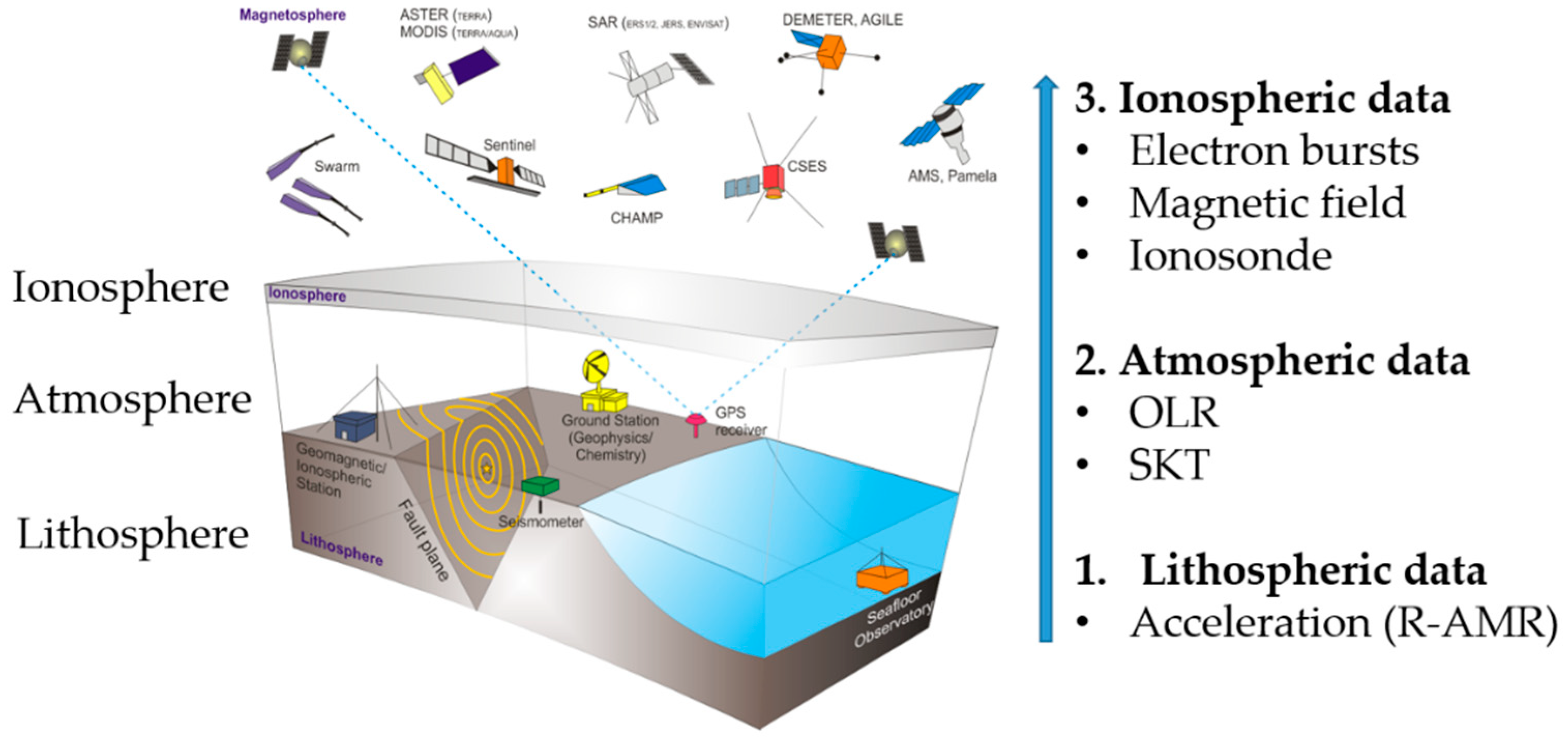
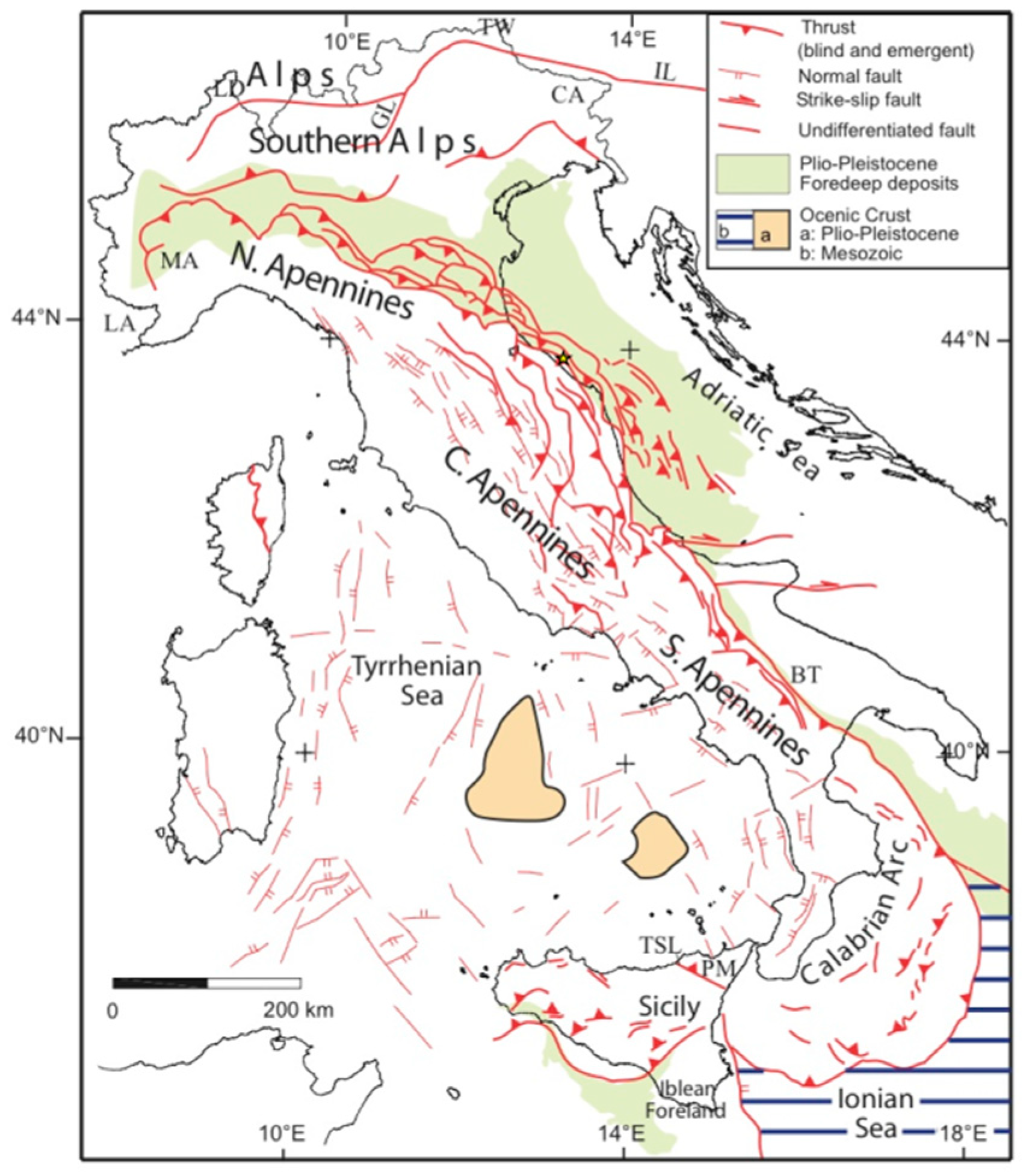

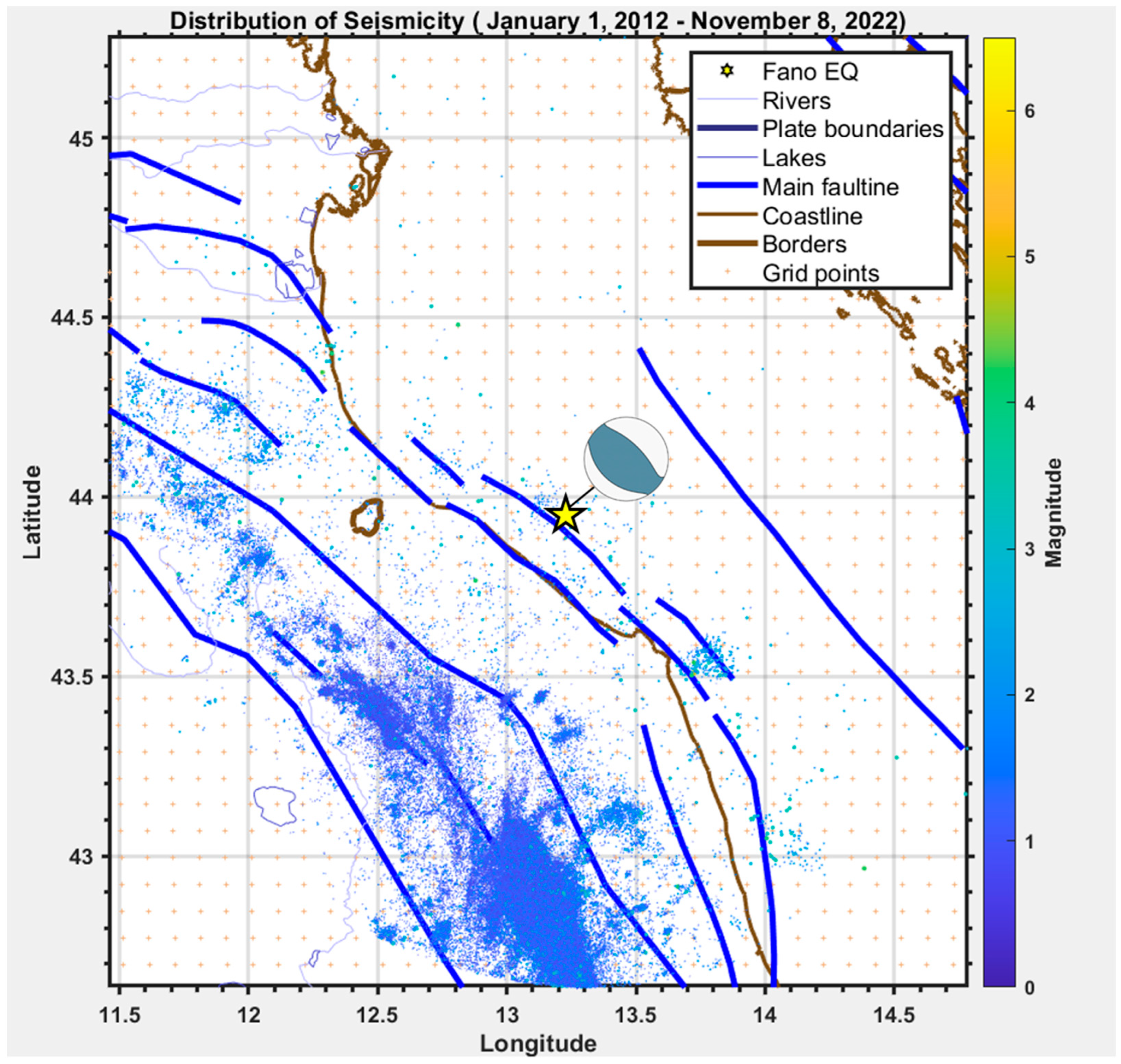

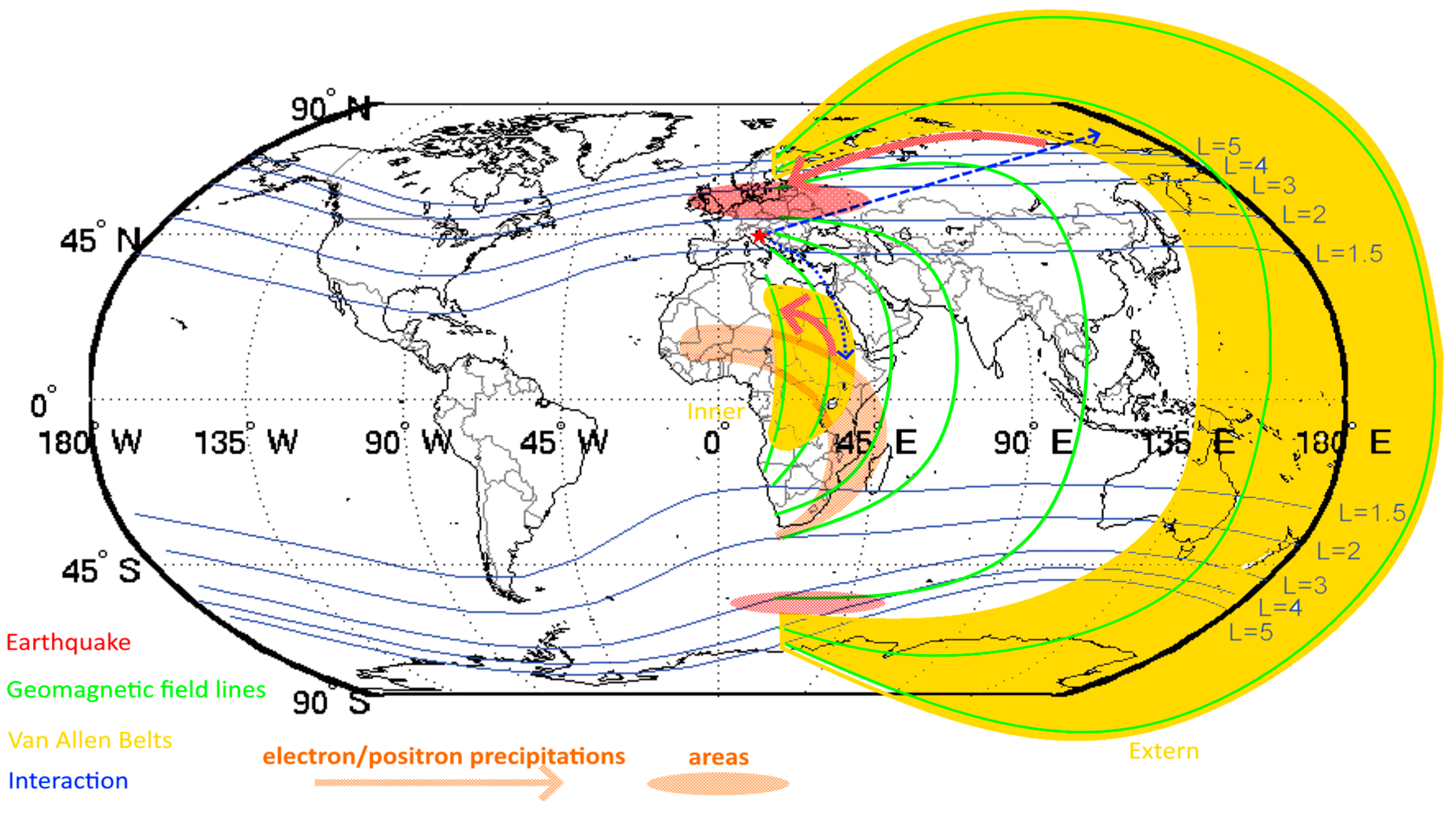



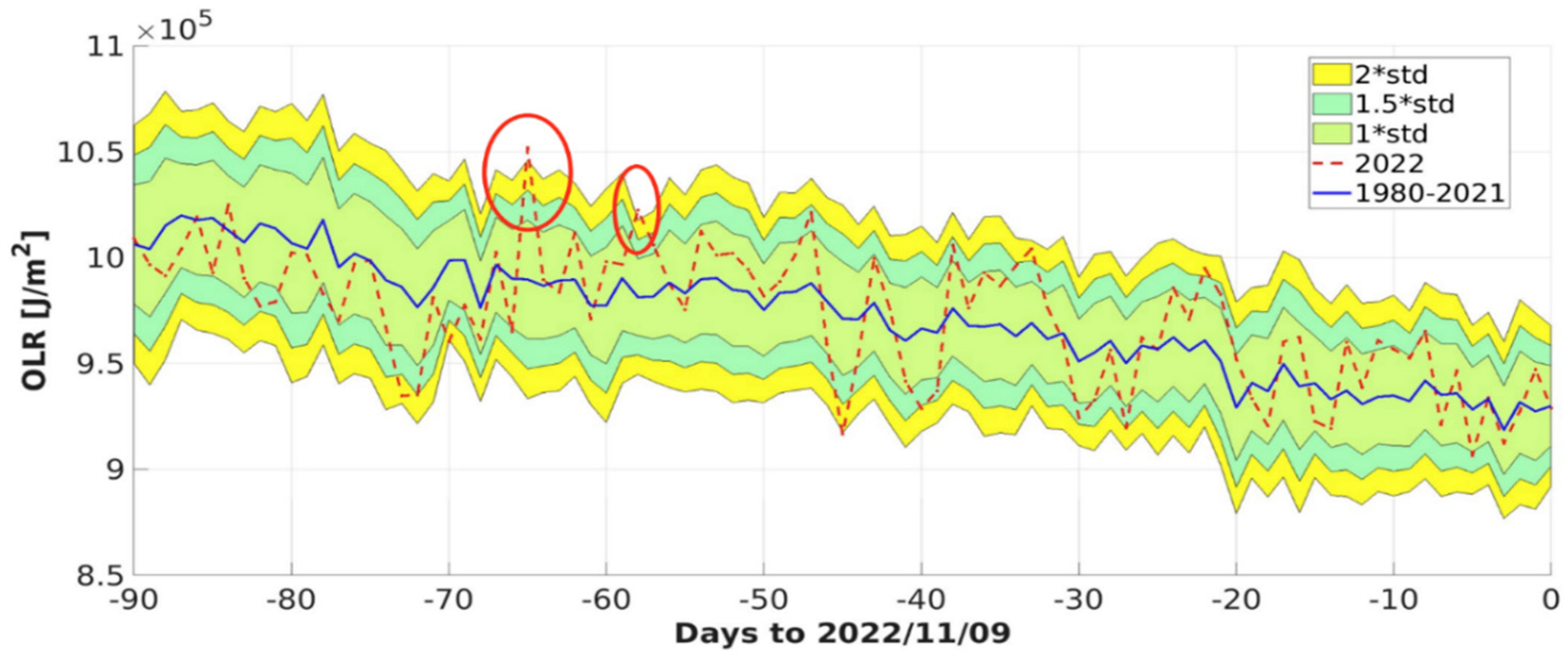
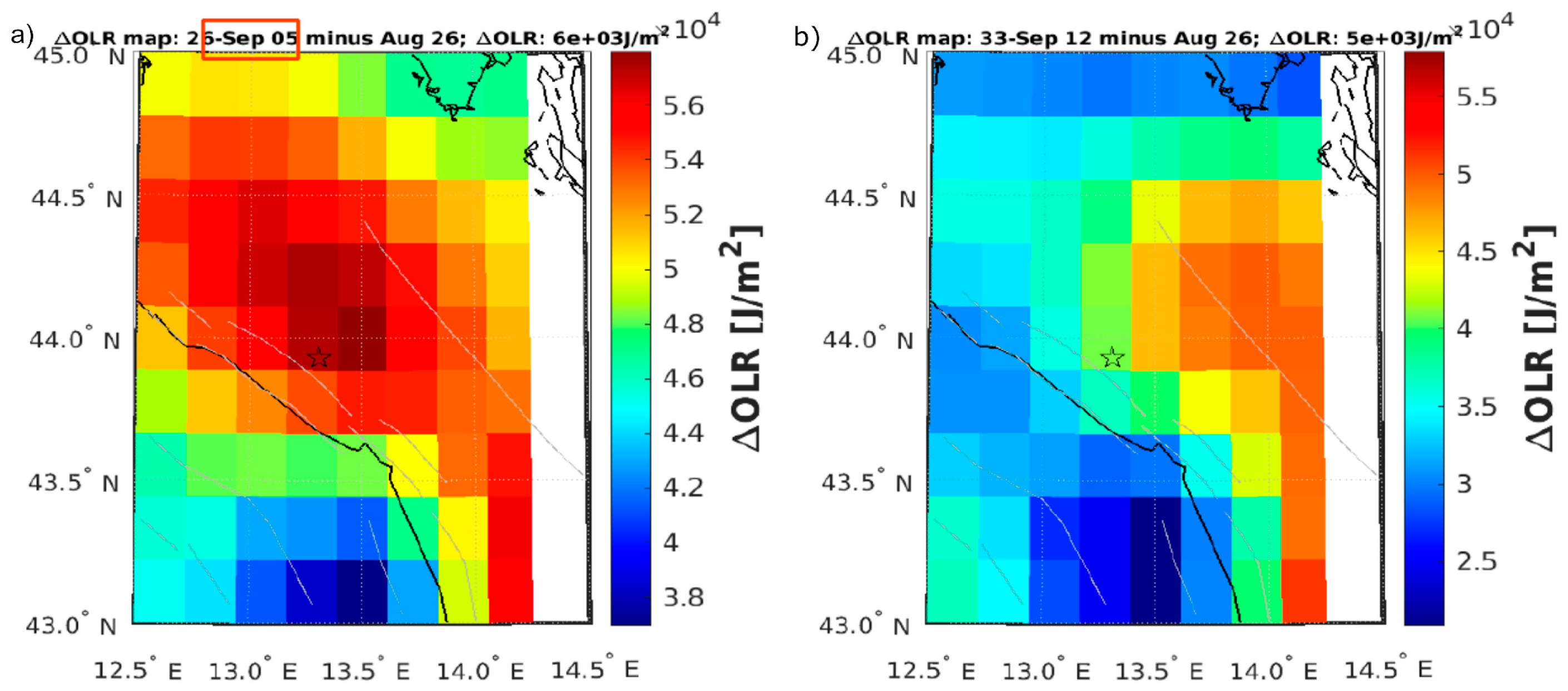
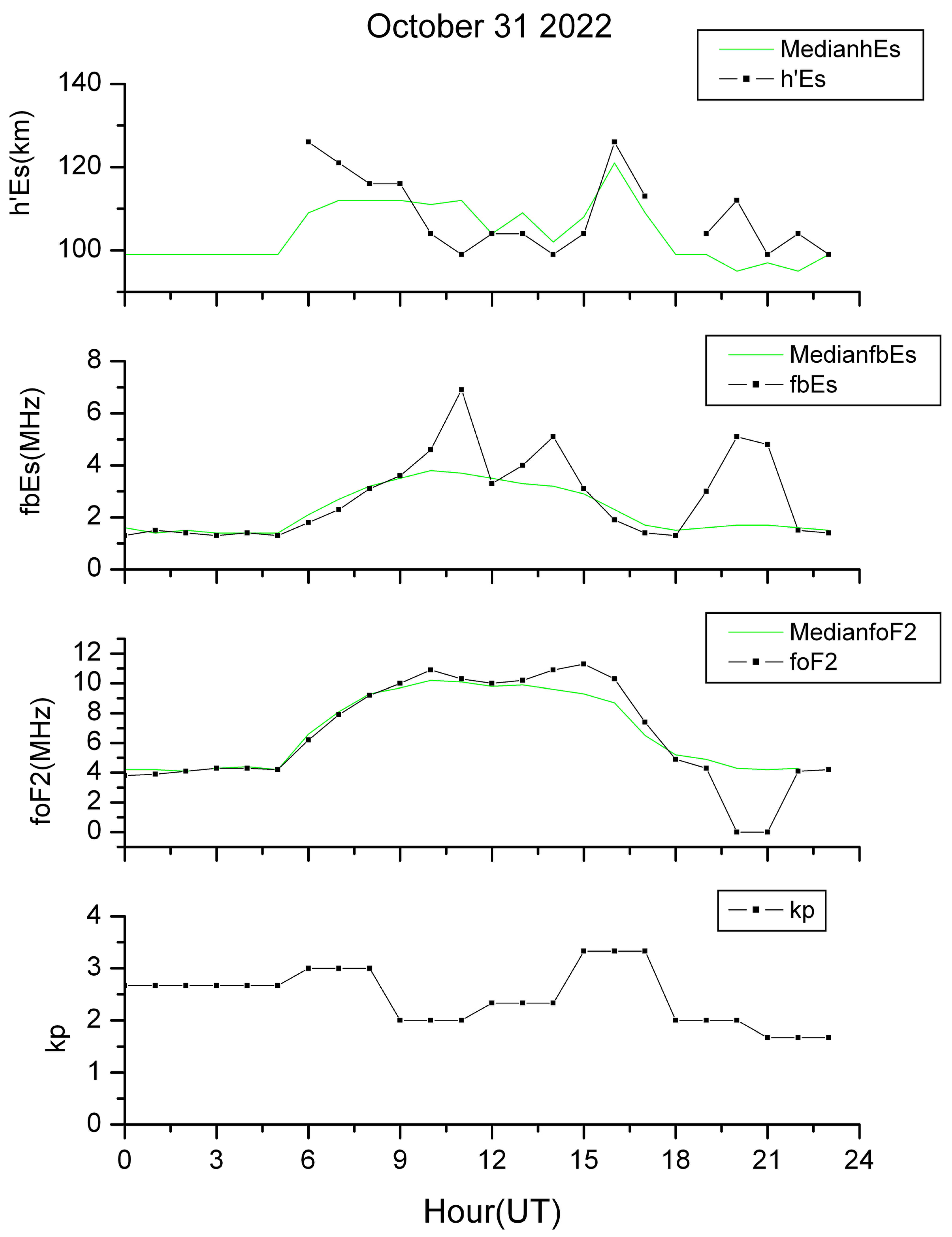

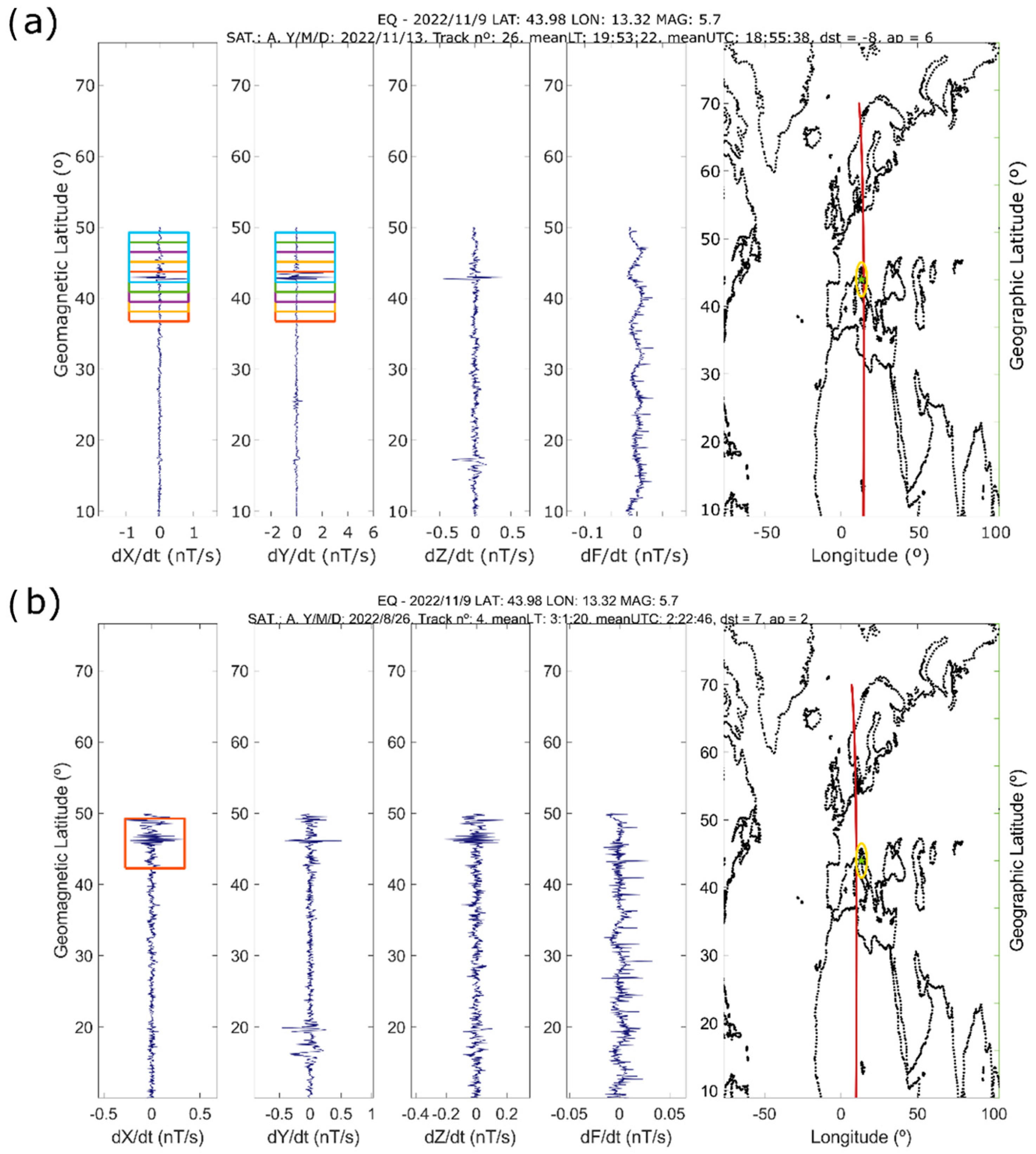


| Date | Hour(UT) | Δh’Es | δfbEs | δfoF2 | ΔT(Days) | Ap Index | AE Index |
|---|---|---|---|---|---|---|---|
| 31 October 2022 | 06–07 | 06–07 | 0.22 | 0.21 | 9 | =11 nT | <300 nT |
| Parameter | Date | Days to Mainshock |
|---|---|---|
| R-AMR | 11 September 2019 | −1155 |
| R-AMR | 11 August 2021 | −455 |
| SKT | 18 August 2022 | −82 |
| Swarm A mag. field | 26 August 2022 | −75 |
| OLR | 05 September 2022 | −65 |
| OLR | 12 September 2022 | −58 |
| SKT | 15 September 2022 | −54 |
| Ionosonde | 31 October 2022 | −9 |
| Electron bursts | 08 November 2022 | −1 |
| Swarm A mag. field | 13 November 2022 | +4 |
Disclaimer/Publisher’s Note: The statements, opinions and data contained in all publications are solely those of the individual author(s) and contributor(s) and not of MDPI and/or the editor(s). MDPI and/or the editor(s) disclaim responsibility for any injury to people or property resulting from any ideas, methods, instructions or products referred to in the content. |
© 2024 by the authors. Licensee MDPI, Basel, Switzerland. This article is an open access article distributed under the terms and conditions of the Creative Commons Attribution (CC BY) license (https://creativecommons.org/licenses/by/4.0/).
Share and Cite
Orlando, M.; De Santis, A.; De Caro, M.; Perrone, L.; A. Campuzano, S.; Cianchini, G.; Piscini, A.; D’Arcangelo, S.; Calcara, M.; Fidani, C.; et al. The Preparation Phase of the 2022 ML 5.7 Offshore Fano (Italy) Earthquake: A Multiparametric–Multilayer Approach. Geosciences 2024, 14, 191. https://doi.org/10.3390/geosciences14070191
Orlando M, De Santis A, De Caro M, Perrone L, A. Campuzano S, Cianchini G, Piscini A, D’Arcangelo S, Calcara M, Fidani C, et al. The Preparation Phase of the 2022 ML 5.7 Offshore Fano (Italy) Earthquake: A Multiparametric–Multilayer Approach. Geosciences. 2024; 14(7):191. https://doi.org/10.3390/geosciences14070191
Chicago/Turabian StyleOrlando, Martina, Angelo De Santis, Mariagrazia De Caro, Loredana Perrone, Saioa A. Campuzano, Gianfranco Cianchini, Alessandro Piscini, Serena D’Arcangelo, Massimo Calcara, Cristiano Fidani, and et al. 2024. "The Preparation Phase of the 2022 ML 5.7 Offshore Fano (Italy) Earthquake: A Multiparametric–Multilayer Approach" Geosciences 14, no. 7: 191. https://doi.org/10.3390/geosciences14070191









